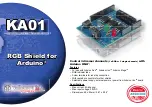
5-218
L90 LINE CURRENT DIFFERENTIAL SYSTEM – INSTRUCTION MANUAL
GROUPED ELEMENTS
CHAPTER 5: SETTINGS
5
CURRENT DIFF SIGNAL SOURCE 1
— This setting selects the first source for the current differential element local operating
current. If more than one source is configured, the other source currents are scaled to the CT with the maximum primary
current assigned by the
CURRENT DIFF SIGNAL SOURCE 1
to
CURRENT DIFF SIGNAL SOURCE 4
settings. This source is
mandatory and is assigned with the
SYSTEM SETUP
SIGNAL SOURCES
SOURCE 1
menu.
CURRENT DIFF SIGNAL SOURCE 2, 3, 4
— These settings select the second, third, and fourth sources for the current differential
function for applications where more than one set of CT circuitry is connected directly to the L90.
CURRENT DIFF BLOCK
— This setting selects a FlexLogic operand to block the operation of the current differential element.
CURRENT DIFF PICKUP
— This setting is used to select the current differential pickup value.
CURRENT DIFF CT TAP 1, 2
— These settings adapt the remote terminal 1 or 2 (communication channel 1 and 2 respectively)
CT ratio to the local ratio if the CT ratios for the local and remote terminals differ. In two-terminal, two-channel applications
use the same value for both TAP 1 and TAP 2 settings, and in three-terminals accordingly remote 1 and 2 CTs. The setting
value is determined by CT
prim_rem
/ CT
prim_loc
for local and remote terminal CTs (where CT
prim_rem
/ CT
prim_loc
is referred to
as the CT primary rated current). Ratio matching must always be performed against the remote CT with the maximum CT
primary defined by the
CURRENT DIFF SIGNAL SOURCE 1
through
CURRENT DIFF SIGNAL SOURCE 4
settings. See the Current
Differential Settings example in the Application of Settings chapter for details.
When an in-zone power transformer is present, calculate and use this setting by taking into account the in-zone power
transformer as follows.
Eq. 5-14
In this equation, V
prim_rem
is primary nominal voltage of the transformer winding at the remote terminal and V
prim_loc
is
primary nominal voltage of the transformer winding at the local terminal.
CURRENT DIFF RESTRAINT 1, 2
— These settings select the bias characteristic for the first and second slope, respectively.
CURRENT DIFF BREAK PT
— This setting is used to select an intersection point between the two slopes.
INRUSH INHIBIT MODE
— This setting selects the mode for blocking differential protection during magnetizing inrush
conditions. Modern transformers can produce small second harmonic ratios during inrush conditions. This can result in
undesired tripping of the protected line. Reducing the second harmonic inhibit threshold can jeopardize dependability and
speed of differential protection. When low, the second harmonic ratio causes problems in one phase only. This can be
utilized to ensure security by applying cross-phase blocking rather than lowering the inrush inhibit threshold.
If set to “Disabled”, no inrush inhibit action is taken.
If set to “Per phase”, the L90 performs inrush inhibit individually in each phase.
If set to “2-out-of-3,” the L90 checks second harmonic level in all three phases individually. If any two phases establish an
inhibiting condition, then the remaining phase is restrained automatically.
If set to “Average”, the L90 first calculates the average second harmonic ratio, then applies the inrush threshold to the
calculated average.
INRUSH INHIBIT LEVEL
—
This setting specifies the level of second harmonic component in the transformer magnetizing
inrush current, above which the current differential element is inhibited from operating. The value of the
INRUSH INHIBIT
MODE
setting must be taken into account when programming this value. This setting is typically programmed as “20% f
0
.“
CURRENT DIFF GND FUNCTION
— This setting enables and disabled the 87LG neutral differential element, which can be used
to detect high-resistive faults. This element uses restrained characteristics to cope with spurious zero-sequence current
during system unbalance and signal distortions. The differential neutral current is calculated as the vector sum of all in-
zone CT input neutral currents. The restraint current is derived as the maximum of phase currents from all terminals
flowing through any individual CT, including breaker-and-a-half configurations. The 87LG neutral differential element is
CURRENT DIFF KEY DTT:
Off
Range: FlexLogic operand
CURRENT DIFF
TARGET: Self-reset
Range: Self-reset, Latched, Disabled
CURRENT DIFF
EVENTS: Disabled
Range: Disabled, Enabled
















































